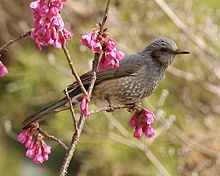
The bulbuls are members of a family, Pycnonotidae, of medium-sized passerine songbirds, which also includes greenbuls, brownbuls, leafloves, and bristlebills. The family is distributed across most of Africa and into the Middle East, tropical Asia to Indonesia, and north as far as Japan. A few insular species occur on the tropical islands of the Indian Ocean. There are 166 species in 32 genera. While different species are found in a wide range of habitats, the African species are predominantly found in rainforest, whereas Asian bulbuls are predominantly found in more open areas.
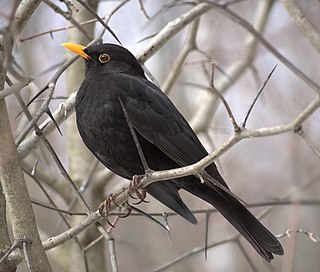
True thrushes are medium-sized mostly insectivorous or omnivorous birds in the genus Turdus of the wider thrush family, Turdidae. The genus name Turdus is Latin for "thrush". The term "thrush" is used for many other birds of the family Turdidae as well as for a number of species belonging to several other families.

The yellow-browed bulbul, or golden-browed bulbul, is a species of songbird in the bulbul family, Pycnonotidae. It is found in the forests of southern India and Sri Lanka. The yellow-browed bulbul is mainly yellow on the underside and olive above with a distinct yellow brow. They are easily located by their loud calls but tend to skulk within foliage below the forest canopy. While its taxonomic classification has changed over time, it is currently the sole species within the monotypic genus Acritillas which is closely related to Hemixos.

The black bulbul, also known as the Himalayan black bulbul or Asian black bulbul, is a member of the bulbul family of passerine birds. It is found primarily in the Himalayas, its range stretching from India eastward to Southeast Asia. It is the type species of the genus Hypsipetes, established by Nicholas Aylward Vigors in the early 1830s. There are a number of subspecies, mostly varying in the shade of the body plumage which ranges from grey to black, and some also occur in white-headed morphs, as also suggested by its specific epithet leucocephalus, literally "white head". The legs and bill are always rich orange-red.
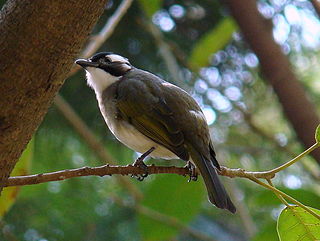
The light-vented bulbul, also called the Chinese bulbul, is a species of bird in the bulbul family found in central and southern China, Hong Kong, Macao, northern Vietnam, southern Japan and Taiwan, with occasional records from South Korea. A common species of songbird that favors lightly wooded habitats, it can frequently be seen in towns, suburbs and urban parks within its range.

The Seram golden bulbul is a species of songbird in the family Pycnonotidae. It is endemic to the Moluccas. Until recently, it was considered conspecific with the northern golden bulbul and the Buru golden bulbul. Its natural habitat is subtropical or tropical moist lowland forests.
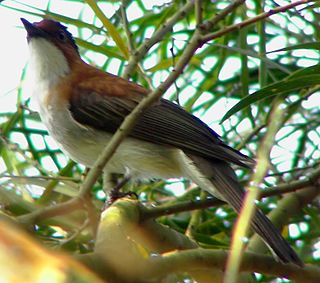
The chestnut bulbul or chestnut-backed bulbul is a songbird in the bulbul family, Pycnonotidae. The species was first described by Robert Swinhoe in 1870. It is found in southern China and northern Vietnam. Its natural habitat is subtropical or tropical moist lowland forests.

Hemixos is a songbird genus in the bulbul family, Pycnonotidae.

Hypsipetes is a genus of bulbuls, songbirds in the family Pycnonotidae. Most of its species occur in tropical forests around the Indian Ocean. But while the genus is quite diverse in the Madagascar region at the western end of its range it does not reach the African mainland.

The mountain bulbul is a songbird species in the bulbul family, Pycnonotidae. It is often placed in Hypsipetes, but seems to be closer to the type species of the genus Ixos, the Sunda bulbul. It is found in Southeast Asia and is not considered a threatened species by the IUCN. It is named after British East India Company Surgeon John McClelland.
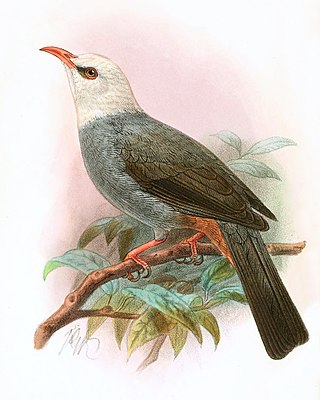
The white-headed bulbul is a songbird species in the bulbul family, Pycnonotidae.
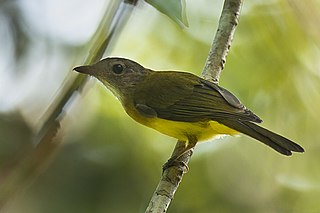
The yellowish bulbul is a species of songbird in the bulbul family, Pycnonotidae.
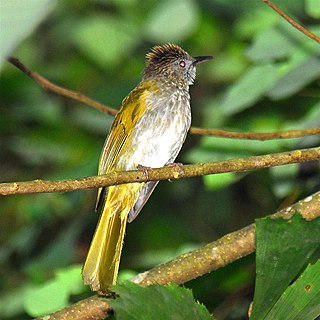
Ixos is a genus of passerine birds in the bulbul family, Pycnonotidae.

The sulphur-bellied bulbul is a songbird species in the bulbul family, Pycnonotidae. It is endemic to Palawan (Philippines). Its natural habitat is subtropical or tropical moist lowland forests. It is not considered a threatened species by the IUCN.

The Philippine bulbul is a songbird species in the bulbul family, Pycnonotidae.
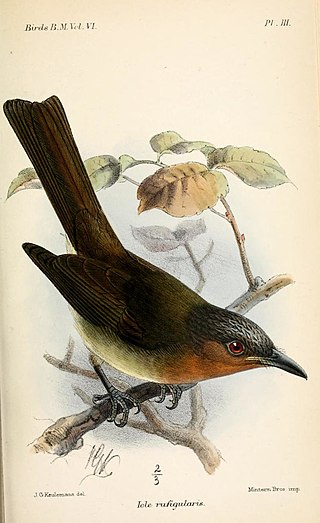
The Zamboanga bulbul is a songbird species in the bulbul family, Pycnonotidae. It is endemic to the Philippines, where its natural habitat is subtropical or tropical moist lowland forests of Basilan and the Zamboanga Peninsula. It is becoming rare due to habitat loss.

The streak-breasted bulbul is a songbird species in the bulbul family, Pycnonotidae.

Iole is a genus of songbirds in the bulbul family, Pycnonotidae. They are native to tropical eastern Asia, from India to China and south through Southeast Asia to northern Indonesia.

The Visayan bulbul or Steere's bulbul, is a songbird species in the bulbul family, Pycnonotidae.



